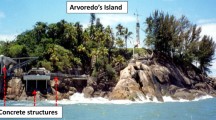Abstract
Laser-induced breakdown spectroscopy has been used for quantitative measurement of trace elements, e.g. sulfur and chlorine, in concrete. Chloride and sulfate ions have a large effect on the durability of concrete structures, and quantitative measurement is important for condition assessment and quality assurance. Concrete is a highly heterogeneous material in composition and grain-size distribution, i.e. the spatial distribution of elements. Calibration plots were determined by use of laboratory-made reference samples consisting of pressings of cement powder, hydrated cement, cement mortar, and concrete, in which the heterogeneity of the material is increasing because of the aggregates. Coarse aggregate and cement paste are distinguishable by the intensity of the Ca spectral lines. More advanced evaluation is necessary to account for the effect of the fine aggregate. The three series of reference samples enable systematic study of the effects of heterogeneity on spectral intensity, signal fluctuation, uncertainty, and limits of detection. Spatially resolved measurements and many spectra enable statistical evaluation of the data. The heterogeneity has an effect on measurement of the sulfur and chlorine content, because both occur mainly in the cement matrix. Critical chloride concentrations are approximately 0.04% (m/m). The chlorine spectral line at 837.6 nm is evaluated. The natural sulfur content of concrete is approximately 0.1% (m/m). The spectral line at 921.3 nm is evaluated. One future application may be simultaneous determination of the amount of damaging trace elements and the cement content of the concrete.








Similar content being viewed by others
References
Taylor HFW (1997) Cement Chemistry, 2nd edition. Thomas Telford Publishing, London, ISBN 0 7277 2592 0
Jungwirth D, Beyer E, Grübl P (1986) Dauerhafte Betonbauwerke: Substanzerhaltung und Schadensvermeidung in Forschung und Praxis. Beton, Düsseldorf, ISBN 3-7640-0210-7
Skalny J, Marchand J, Odler I (2002) Sulfate Attack on Concrete, SPON Press, London and New York, ISBN 0 419 24550 2
Springenschmidt R (1989) Arbeitskreis “Prüfverfahren Chlorideindringtiefe” des Deutschen Ausschusses für Stahlbeton: Anleitung zur Bestimmung des Chloridgehaltes von Beton. Beuth Verlag GmbH, Berlin
ASTM C 1202-97: Standard Test Method for Electrical Indication of Concrete’s Ability to Resist Chloride Ion Penetration, American Society for Testing and 6 Materials, West Conshohocken, Philadelphia, USA 1997, American Society for Testing and Materials, ASTM Norm
DIN EN 197-1, edition 2004-08, Beuth Verlag GmbH, Berlin
Wiens RC, Sharma SK, Thompson J, Misra A, Lucey PG (2005) Joint analyses by laser-induced breakdown spectroscopy (LIBS) and Raman spectroscopy at stand-off distances. Spectrochim Acta A 61:2324–2334
Durdragne L, Adam P, Amouroux J (1998) Time-Resolved Laser-Induced Breakdown Spectroscopy: Application for Qualitative and Quantitative Detection of Fluorine, Chlorine, Sulfur and Carbon in Air. Appl Spectrosc 52(10):1321–1327
Weritz F, Ryahi S, Schaurich D, Taffe A, Wilsch G (2005) Quantitative determination of sulfur content in concrete with laser-induced breakdown spectroscopy. Spectrochim Acta B 60:1121–1131
Asimellis G, Hamilton S, Giannoudakos A, Kompitsas M (2005) Controlled inert gas environment for enhanced chlorine and fluorine detection in the visible and near-infrared by laser-induced breakdown spectroscopy. Spectrochim Acta B 60:1132–1139
Wiggenhauser H, Wilsch G, Schaurich D, Wöstmann J (2000) Analysis of Concrete Using LIBS, INSIGHT 42(7):436–438
Coulomat CS 30 HT, Behr Labortechnik, http://www.behr-labor.com
Wilsch G, Weritz F, Schaurich D, Wiggenhauser H (2005) Determination of chloride content in concrete structures with laser-induced breakdown spectroscopy. Constr Build Mater 19:724–730
Author information
Authors and Affiliations
Corresponding author
Rights and permissions
About this article
Cite this article
Weritz, F., Schaurich, D., Taffe, A. et al. Effect of heterogeneity on the quantitative determination of trace elements in concrete. Anal Bioanal Chem 385, 248–255 (2006). https://doi.org/10.1007/s00216-006-0362-0
Received:
Revised:
Accepted:
Published:
Issue Date:
DOI: https://doi.org/10.1007/s00216-006-0362-0




